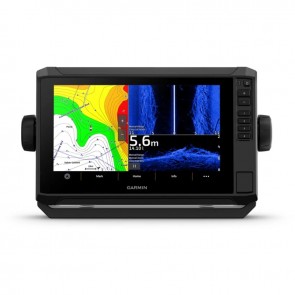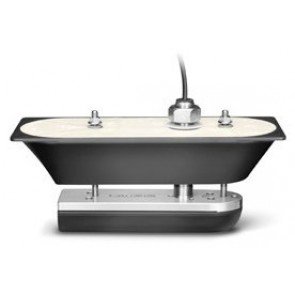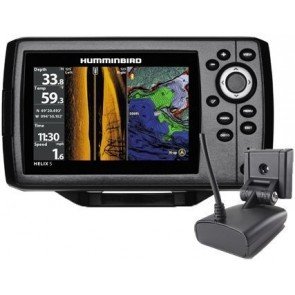Side Imaging
Similar Terms: Side Scan, SideVu, SideVü
Side Imaging (Humminbird), also known as Side Scan (Lowrance), SideVu (Garmin), Side Looking or Bottom Classification is a mode of sonar operation that is capable of differentiating between materials and texture types on the bottom. Side Imaging provides an underwater view similar to an Aerial photograph, of the bottom of the waterway to the sides of the Boat, instead of only displaying what is below the Boat, as in down imaging or down scan.
Side Imaging works by pulsing sonars in a fan or cone shape over a wide angle, perpendicular to the path of the transducer. The returns from these Sonar beams are collected in small slices and the slices pieced together to form a complete image. Side Imaging transducers usually operate between 100kHz and 500kHz.
Fishfinders utilising side imaging technology can usually scan an area about 150m wide (75m to each side of the boat) and to a depth of about 45m at 455kHz. The side-angle beams are often set at either 455kHz or 800kHz providing a wider indepth scan area or better image Resolution respectively.
Boat Speed/ Direction/ Orientation: The optimum Boat speed for side imaging is between 2 to 6 knots; too fast and data from some of the image slices will be missed. For optimal results, the Boat should be moving in a straight Line, as a turning Boat causes the Sonar pulse returns to overlap resulting in image distortion. Also, side to side rocking of the Boat (ie waves) can cause image distortion. If you use side imaging in wavy conditions then point the Boat into the waves instead of running parallel to them to avoid side to side motion of the Boat.

Lowrance DownScan (top right), Traditional 2d Sonar (bottom right) and SideScan (left)

Humminbird Down Imaging (top left), Traditional 2d Sonar (bottom left) and Side Imaging (right)
Related Products
-
Garmin GPSMAP 8412xsv Combo
From: RRP $5,799.00
$5,149.00
-
Simrad NSX 3009 Combo with Active Imaging 3-1 & Discover X C-MAP
RRP: $2,399.00
NOW: $1,995.00
-
Simrad NSX 3012 Combo with Active Imaging 3-1 & Discover X C-MAP
RRP: $4,199.00
NOW: $3,639.00
-
StructureScan 3D
RRP: $1,550.99
NOW: $1,329.00
-
Garmin Echomap UHD2 95sv Combo
RRP: $2,199.00
NOW: $1,949.00
-
Garmin GT56UHD-TM T/M High-Wide Transducer
RRP: $749.00
NOW: $679.00
-
Garmin GT54UHD-TM Ultra High Definition All In One Transducer
RRP: $599.00
NOW: $579.00
-
Humminbird Plastic Thru Hull Transducers
From: RRP $409.90
$373.00
-
Humminbird Trolling Motor Mount Transducers
From: RRP $249.90
$210.50
-
Humminbird Autochart Software
From: RRP $589.00
$513.00
-
Humminbird XNT 9 SI 180 T Transom Transducer
RRP: $689.00
NOW: $640.00
-
Garmin GT51 Series Transducers - Mid Band Chirp DV/SV 260/455Khz Thru Hull
RRP: $1,499.00
NOW: $1,469.00
-
Garmin GT-30 Series Transducers
From: RRP $1,499.00
$1,425.00
-
Garmin GT41 Series Transducers
From: RRP $949.00
$902.50
-
Garmin GT50 Series Transducers
From: RRP $759.00
$722.00
-
Garmin GT51 Series Transducers
From: RRP $999.00
$931.00
-
Humminbird 360 Degrees Imaging Transducer
RRP: $3,079.00
NOW: $2,874.50
-
Garmin GT51 Series Transducers - GT51M-TM Mid Band CHIRP DownVu & SideVu 260/455Khz T/M Transducer - 12 Pin
RRP: $999.00
NOW: $931.00
-
Garmin GPSMAP 1022xsv Chartplotter Combo
RRP: $2,599.00
NOW: $2,379.00
-
Humminbird Helix 5 CHIRP SI GPS G2 Combo
From: RRP $889.00
$845.00
























